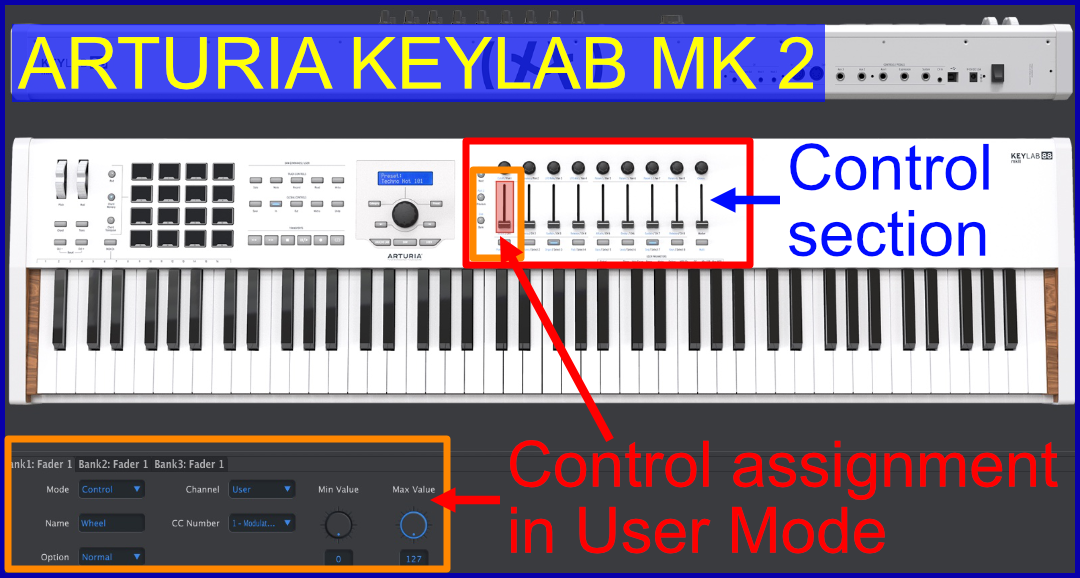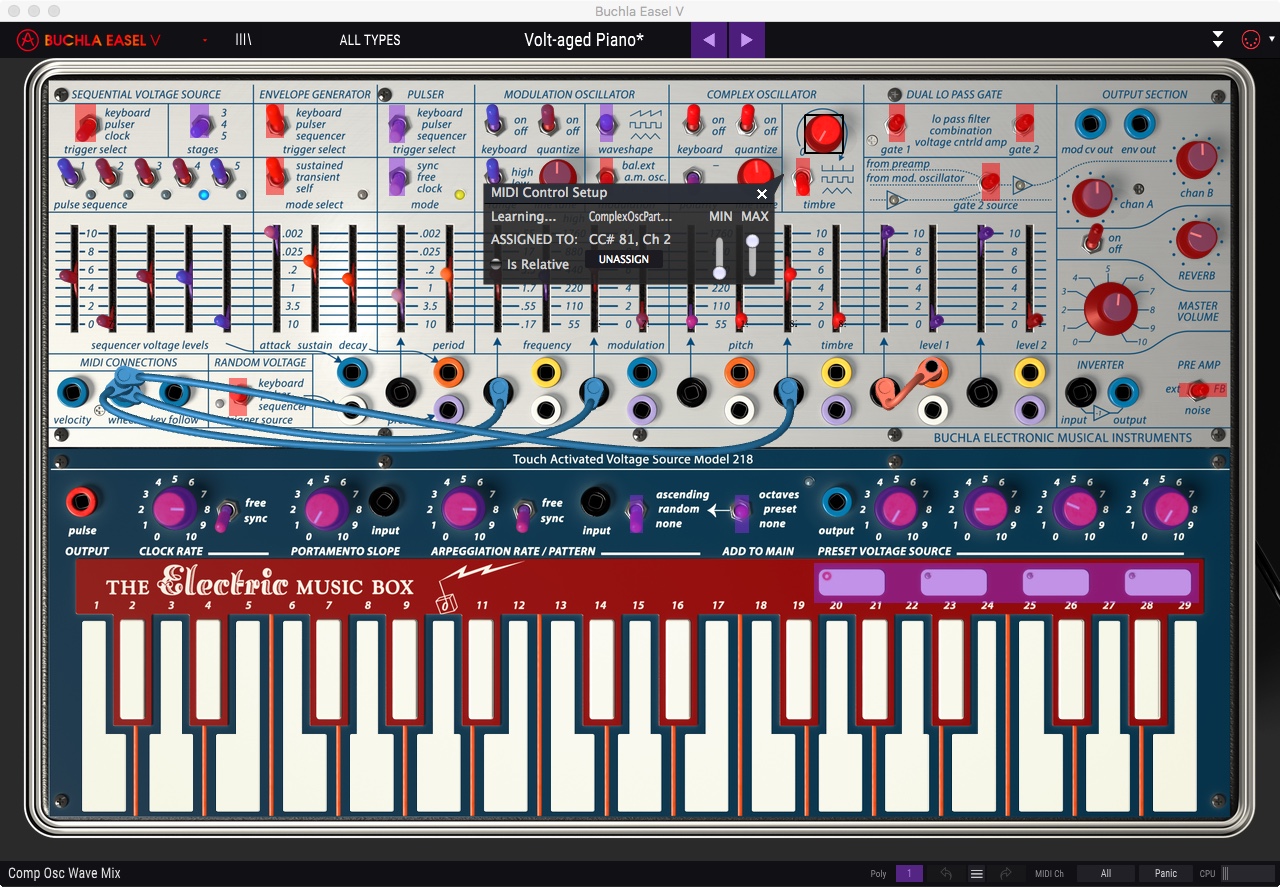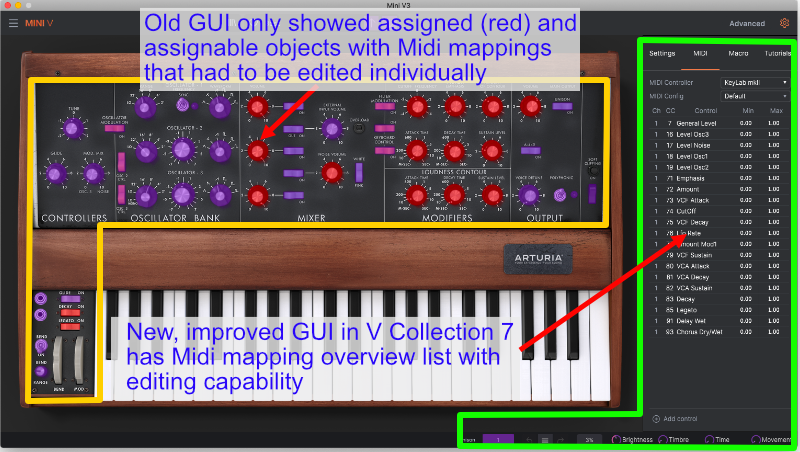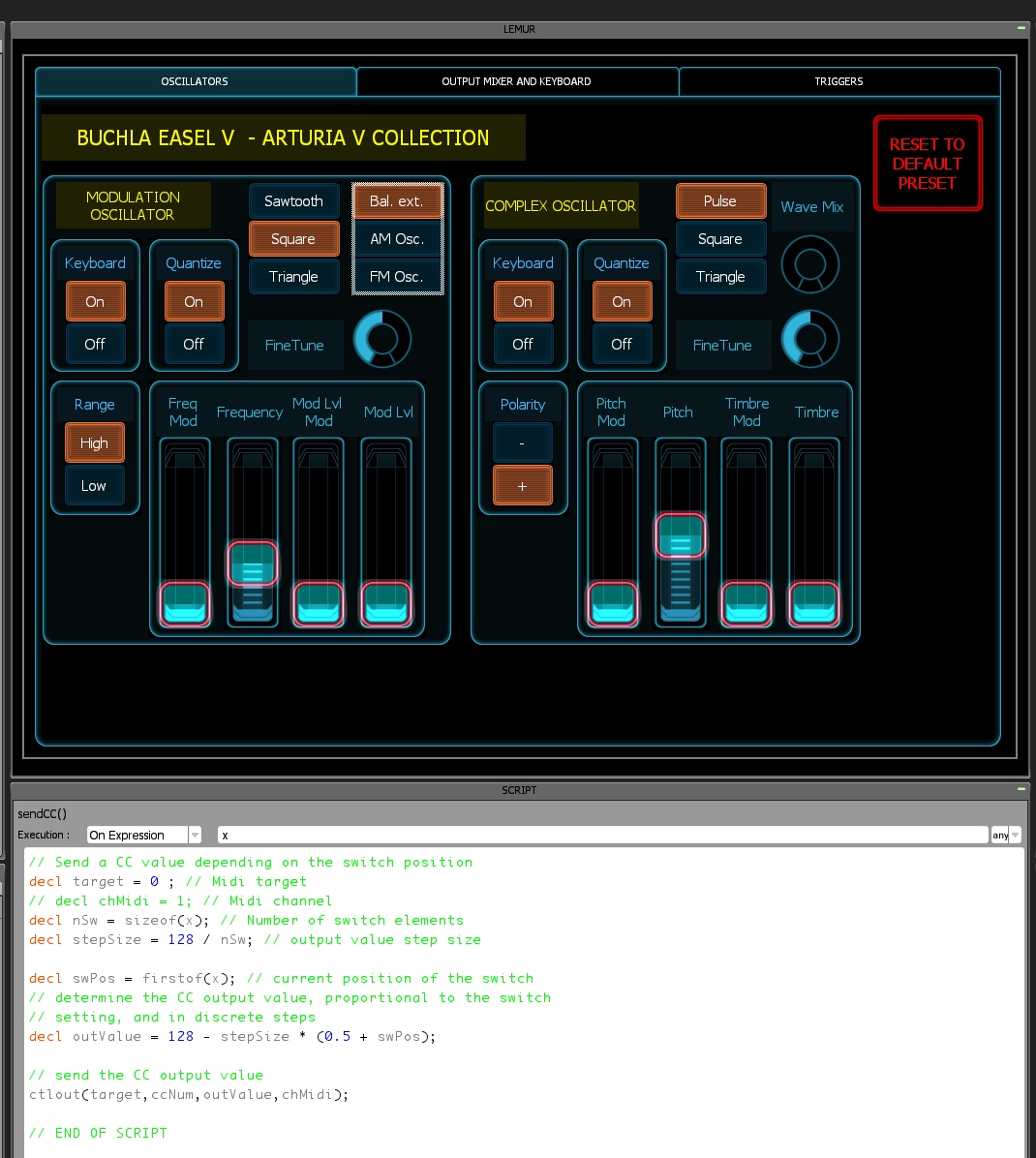Homepage > Documents > Arturia V Collection Default Midi Controller Configuration
Virtual instrument midi control
Default Midi controller configuration of the Arturia V Collection instruments
This page contains a link to a PDF table with the default Midi controller configuration for all software instruments in the - Arturia V Collection - (see below).
Finding the Midi Configuration >> | Overview table >> | Conclusion >>
Introduction
 The Arturia V Collection contains software model implementations of classical analog and digital synthesizers, samplers, pianos and organs. With the Arturia Midi Control Center software it is possible to create Controller Maps for hardware controllers such as the Arturia KeyLab Mk 2 shown in the figure. This keyboard has a set of 27 controls, assignable in 3 banks; the total of knobs, faders and buttons therefore is 81.
The Arturia V Collection contains software model implementations of classical analog and digital synthesizers, samplers, pianos and organs. With the Arturia Midi Control Center software it is possible to create Controller Maps for hardware controllers such as the Arturia KeyLab Mk 2 shown in the figure. This keyboard has a set of 27 controls, assignable in 3 banks; the total of knobs, faders and buttons therefore is 81.
When designing a controller map we must know the Midi Controller Configuration of the instrument from the Arturia V Collection. This information is also relevant when designing a Liine Lemur controller interface with control objects.
Finding the default Midi configuration for V Collection instruments
 Each instrument in the Arturia V Collection has a set of predefined controller objects in the Default Midi Controller Configuration. The example shown here is for the Buchla Easel. The control elements with red rectangles are included in the predefined set. In order to find the Midi controller assignment one has to click on the object and read the information from the black pop-up window (Midi CC number, channel, controller type and value range). There is no overview list of these assignments, neither in the virtual instrument GUI, nor on the Arturia website. Finding these default Midi controller assignments is a tedious task, that has to be performed for all instruments in the collection. The purple rectangles show the controller objects that may be assigned in a User Midi Controller Configuration. These are not included in the data overview presented here.
Each instrument in the Arturia V Collection has a set of predefined controller objects in the Default Midi Controller Configuration. The example shown here is for the Buchla Easel. The control elements with red rectangles are included in the predefined set. In order to find the Midi controller assignment one has to click on the object and read the information from the black pop-up window (Midi CC number, channel, controller type and value range). There is no overview list of these assignments, neither in the virtual instrument GUI, nor on the Arturia website. Finding these default Midi controller assignments is a tedious task, that has to be performed for all instruments in the collection. The purple rectangles show the controller objects that may be assigned in a User Midi Controller Configuration. These are not included in the data overview presented here.
V Collection 7 / 8 update with improved Midi configuration overview and editing
 In a long memorandom to Arturia I have been reporting my experience, errors and improvement suggestions with/for the hardware and software products (see above and in various Monthly News items in 2019 and 2020). This included the hassle of inspecting the Midi assignments for each GUI object separately, an error-prone process. I was disappointed for never receiving an answer from the company. Now I am happy to see that with the V Collection 7 / 8 update and the new GUI (December 2020) there is a panel with a Midi configuration overview list and with editing capabilities. So, maybe they have been listening after all.
In a long memorandom to Arturia I have been reporting my experience, errors and improvement suggestions with/for the hardware and software products (see above and in various Monthly News items in 2019 and 2020). This included the hassle of inspecting the Midi assignments for each GUI object separately, an error-prone process. I was disappointed for never receiving an answer from the company. Now I am happy to see that with the V Collection 7 / 8 update and the new GUI (December 2020) there is a panel with a Midi configuration overview list and with editing capabilities. So, maybe they have been listening after all.
 Determining the default Midi controller configuration is useful when implementing a controller mapping on hardware controllers, such as the Arturia KeyLab, or when designing a controller with a generic tool such as Liine Lemur. Part of the iPad Lemur GUI design for the Buchla Easel is shown in the image. The objects in this GUI have specific Midi CC assignments, corresponding to the default configuration for the virtual instrument. With clever preparation, e.g., looking for similarities in the default Midi configurations, one may reduce the controller design and implementation work for the complete set of instruments. That is the information overview presented in the table in the next section.
Determining the default Midi controller configuration is useful when implementing a controller mapping on hardware controllers, such as the Arturia KeyLab, or when designing a controller with a generic tool such as Liine Lemur. Part of the iPad Lemur GUI design for the Buchla Easel is shown in the image. The objects in this GUI have specific Midi CC assignments, corresponding to the default configuration for the virtual instrument. With clever preparation, e.g., looking for similarities in the default Midi configurations, one may reduce the controller design and implementation work for the complete set of instruments. That is the information overview presented in the table in the next section.
The overview table with the Default Midi Controller Configuration
The full table with the default Midi controller configuration may be found here Arturia V Collection default Midi controller configuration table >> (PDF, 3 pages, paper size A3 landscape) [Update December 2021, Analog Lab MIDI mapping added, modified table layout]:
An excerpt from that table is shown below, focusing on a number of analog and digital synthesizers from the V Collection, with a brief analysis and interpretation of the results.
| Midi | Arturia V Collection Instrument (excerpt from the full table) | ||||||
|---|---|---|---|---|---|---|---|
| CC | ARP 2600 | Buchla Easel | DX-7 | Jupiter-8 | Matrix-12 | Mini V3 | Prophet |
| 7 | Vol | LP Gate 2 mode | Vol | Vol Ch 6 | Vol | Vol | |
| 16 | Ring Mod lvl | Osc Kbd Sc on/off, Chan A lvl (Ch 2) | LFO 1 wave | VCO 2 range | VCO 2 pulse width | Osc 3 lvl | Mix noise |
| 17 | ADSR L | LP Gate lvl 2, Chan B lvl (Ch 2) | LFO 1 delay | VCO 1 VCO 2 mod | Noise lvl | Filt Env amnt | |
| 18 | Noise Fco | ModOsc quant on/off, LP Gate src (Ch 2) | Algorithm | HPF Fco | Filt mode; | Osc 1 lvl | Mix Osc A |
| 19 | Noise lvl | Osc pitch lvl, Pre Amp src (Ch 2) | Portamento time | VCF LPF env mod | VCO 1 pulse width | Osc 2 lvl | Mix Osc B |
| 71 | Resonance | Env Tsus, Master vol (Ch 2) | VCF LPF res | Filter resonance | Filter emph | Filter resonance | |
| 72 | Trel | Seq trigger, Mod Osc HF mode (Ch 2) | Op 3 lvl | Env 2 Trel | Filter amount | Filter Env Trel | |
| 73 | Tatt | Seq Pulse 2, Mod Osc HF mode (Ch 2) | Env 2 Tatt | Tatt | Filter Env Tatt | ||
| 74 | Fco | Pulse Tper, Mod Osc HF lvl (Ch 2) | VCF LPF cut | Filter Fco | Fco | Filter Fco | |
| 75 | Tdec | Seq pulse 3, Mod Osc HF lvl (Ch 2) | Op 1 lvl | Env 2 Tdec | Tdec | Filter Env Tdec | |
| 76 | LFO speed | Env Tdec, Seq lvl 1 (Ch 2) | LFO 1 rate | LFO rate | LFO 1 speed | LFO rate | LFO speed |
| 77 | Vib depth | Env trigger, Seq lvl 2 (Ch 2) | LFO 1 PMD | LFO 5 speed | Mod wheel amount | LFO noise | |
| 79 | Lsus | Seq Pulse 4, Osc quant on/off (Ch 2) | Op 2 lvl | Env 2 Lsus | Lsus | Filter env Lsus; | |
| 80 | Rand trigger, Osc timbre waves (Ch 2) | Env 1 Tatt | Env Tatt | Loudness Tatt | Amp Env Tatt | ||
| 81 | Mod Osc LF mod, Osc timbre (Ch 2) | Op 4 lvl | Env 1 Tdec | Env Tdec | Loudness Tdec | Amp Env Tdec | |
| 82 | VCO 1 finetune | Osc timbre lvl (Ch 2) | Op 5 lvl | Env 1 Lsus | Env Lsus | Loudness Lsus | Amp Env Lsus |
| 83 | VCO 2 finetune | Mod Osc finetune, Osc timbre lvl (Ch 2) | Op 6 lvl | Env 1 Trel | Env Trel | Dec on/off | Amp Env Trel |
| 85 | VCO 3 finetune | Mod Osc src, LP Gate 1 mode (Ch 2) | Feedback lvl | VCA Env 2 lvl | Leg on/off | Filter kbd | |
| 91 | Delay D/W | Rev lvl (Ch 2) | VCO 2 freq | Delay D/W | Delay D/W | ||
| 93 | Chorus D/W | Env mode, Seq lvl 3 (Ch 2) | VCO 1 freq | Chorus D/W | Chorus D/W | ||
Analysing this table reveals a number of findings that will be relevant for Midi controller design and implmentation.
- All instruments have Midi controller assignment for Channel 1 only, the exception being the Buchla Easel, which uses the same CC numbers on 2 channels.
- Most instruments have 10-20 controller assignments in the default configuration. The minimum number is 2 for the Piano instrument, the most extended are the implementations for the Solina and VOX instruments.
- Note that the configurations use "standard" blocks of Midi CC numbers. We see the set of General Purpose Controller numbers CC16-19 plus CC80-83, the Sound Controllers (Midi CC71-79, omitting CC70 and skipping CC78), plus the Effects CC91 and CC93. Also note skipping the numbers CC84 and CC86 (reasons unknown). This information is helpful when optimizing controller design, using common blocks of GUI controller elements.
- The Control Parameter is fairly consistent for these common blocks of CC numbers. For example, note CC7 for Volume, CC71 for Filter Resonance, and CC73 for envelope Tattack. Again, use these common parameter assignments in controller design.
- So the Arturia programmers must have coordinated the default Midi Controller Configuration implentation over the total set of instruments in the collection. It is a pity that this information is not available online (to the best of my knowledge).
Conclusion
This page provides a link to a free PDF table with the default Midi configuration for all instruments in the Arturia V Collection. This information is needed when designing Midi controllers, but is not available on the Arturia Website. It is quite tedious to compile, and I decided to offer the results from that process as a free service. Also I communicated my findings and and information overview request to the Arturia company.
Note: The PDF table only shows the Default Midi Controller Configuration. Each instrument GUI has many more assignable objects, and in order for these to respond to external controls one has to define a specific User Midi Configuration. The table presented here, however, is a good starting point for controller design.
